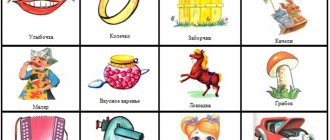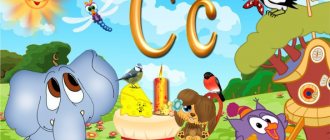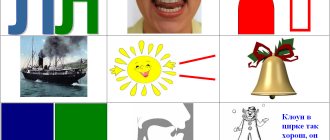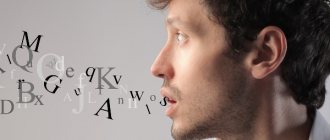Children have various problems with many letters in the process of speech formation. One of the most common difficulties is setting the sh sound. Typically, children find it difficult to pronounce hissing sounds for the reason that they cannot relax the tongue and position it in the required shape, which is required by the correct articulation of the sound sh.
How to check your child's pronunciation?
It often happens that the first to point out problems with a baby’s sound pronunciation are caregivers, teachers, or people who hear the baby speak for the first time. It is sometimes difficult for parents to notice the peculiarities of their child’s speech, since as a result of constant communication, we get used to the way the baby speaks. There are two ways to notice difficulties in pronouncing the sound “Ш” at home:
- Observation. This diagnostic option requires quite a long time and increased attention from adults.
- Exercises. Using various tasks (with gradually increasing difficulty levels), you can check how your child pronounces the sound “Ш”.
- Snake. Ask your baby to sound out the hissing sound of the snake (“sh-sh-sh-sh-sh”).
- “Repeat the syllables.” Start with combinations of two letters (“sha”, “shi”, “shu”, “ish”, “osh” and so on), then use combinations of three letters (“u-shu”, “a-sha”, “ e-she", "o-sho" and others). The most difficult combinations are with consonants (for example, “kshi”, “shka”, “shki”, “sshi”, “pshi”).
Pronounce all sounds clearly and with pronounced articulation. Children often pick up incorrect pronunciation from adults, so parents need to closely monitor the purity of their own speech.
- “Say the word.” For this exercise, you need to prepare cards in advance with images of objects known to the little ones, the names of which contain the sound you need. Examples of words: neck, hat, mouse, car, lily of the valley, cone, fur coat, galoshes, cat, rustles, rough, ball and so on.
- Phrases and sentences with the sounds “Ш”. This is the highest level of difficulty, since in order to pronounce sentences correctly, you need good articulation. Examples: “the cat is running after the mouse”, “Sasha was walking along the highway”, “a rough bump”, “Mom sewed me panties”, “Dasha put on a warm scarf”, “Misha splashes through the puddles”.
Pronunciation check
Parents can check the correct pronunciation of sounds by their child themselves. There are different tests for this. You can use the same technique with which speech therapists evaluate a child’s speech at the first appointment: ask to pronounce words or syllables containing hissing sounds (for example, noise, school, came, bumblebee).
To pronounce W correctly, the tongue should be like a ladle, located in the center of the oral cavity, and not stick out forward. It is important that the tip points upward.
The verification should be carried out in stages:
- The first stage is a general check. You need to ask the child to say a couple of easy sentences that contain words with a letter (for example, “you should wear a scarf in winter,” “the cat caught the mouse”). Next, you need to move on to the pronunciation of individual words (edge, hat, good, porridge);
- the second stage is checking the sound of Ш in isolation. Attention is paid to syllables. You need to ask the baby to say “OSH”, “SHA”, “OSHO”, “USHU”. This will allow you to find out how well the child can pronounce sounds. It happens that such a check reveals problems with vowel sounds. Therefore, it is recommended to vary the syllables;
- the third stage is testing in individual syllables with voiceless and voiced consonants.
To check the pronunciation of different sounds, there are special cards with bright pictures. They are sold in children's stores. Thanks to such cards, the test can be carried out in the form of an enjoyable game.
Options for incorrect pronunciation of the sound “SH”
Ideally, the sound “Ш” should be pronounced clearly and quite loudly (despite the fact that it is a voiceless consonant). Preschool children can change this sound in different ways in their speech. Speech therapists identify the following possible deviations:
- Interdental pronunciation. If the baby pushes his tongue forward too much, a lisp is heard in his speech (the sound “Sh” sounds like “F”).
- Nasal pronunciation (“Sh” turns into “X”) occurs when the root of the tongue rises to the hard palate and air passes through the gap between them.
- Whistling pronunciation (replacing “Sh” with “S”).
- The soft pronunciation (“Sh'” instead of “Sh”) occurs because the tongue is pressed against the lower front teeth.
- If the tongue rests on the upper incisors, a “T” sound is produced.
- Air flow may pass between the cheek and molars, resulting in a popping or squelching sound. The child accurately pronounces the sound “Ш” incorrectly if at this moment his cheeks swell.
Sometimes babies can pronounce the sound “Sh” quite clearly if their articulation organs are in the wrong position. Therefore, it is necessary to monitor exactly how the child produces sound.
Types and mechanisms of violations
Incorrect pronunciation of a hissing group is called sigmatism, and their replacement with other sounds is called parasigmatism. Sh may be absent from a child’s speech, but he will not replace it with other phonemes. There are several types of hissing sigmatism, differing in the mechanism of occurrence:
- Interdental – speech with such distortion is called a lisp. With this sigmatism, the tongue does not take the desired “cup” position, but passes between the teeth. The cause may be a short hyoid frenulum; high and narrow sky.
- Lateral - in speech, instead of Ш, a sound is produced that has a “squelching” sound. During pronunciation, one corner of the lips rises higher than the other; the lower jaw is also shifted to one side; the “cup” shape does not work out because the back of the tongue forms a connection with the dental alveoli on only one side. The reason for the appearance of such distortion may be weak tone of the articulatory muscles and incorrect bite.
- Nasal - instead of Ш, the child pronounces X with a nasal connotation. The tongue is in a lower position, and the back is raised up. It is because of the high tension on the back of the tongue that this sigmatism appears.
Depending on the type of hissing sigmatism, the speech therapist will select the method of sound production.
What prevents a child from “hissing”?
There are two groups of reasons why babies fail to pronounce the sound “Ш” correctly. Physiological reasons include:
- Insufficient development and immobility of the articulatory apparatus;
- Malocclusion (often caused by prolonged use of a pacifier);
- Short frenulum of the tongue;
- High palate;
- Oral diseases;
- Difficulties in phonemic perception (the child does not distinguish some sounds by ear);
- Hearing impairment;
The second group of factors are the mistakes of adults who are around the child.
- “Lisping” from adults;
- Incorrect pronunciation by adults (children always repeat after us).
Study Materials
Poetry
* * * What do we have in the forest starting with the letter Sh? This cone flopped, rustling. A bumblebee and a hornet are noisily rummaging through the porridge. Insects rustle in the rose hips. What else in the forest begins with the letter Sh? Noise and rustling near the hut.
Poems about the letter "SH"
Puzzles
* * * Together Pasha and Yegor set up a tent in the field. Right next to the hut, And the tent became a letter...
Riddles about the letter "SH"
Tongue Twisters
* * * The letter Sh bought silk. The letter knows a lot about silk. She sews shorts, skirts, hats, shawls, even fur coats from silk.
Tongue twisters starting with the letter "SH"
Fairy tales
About the letter Sh
Once upon a time there lived in the ABC the letter Ш. It was already quite old, however, like all letters, and stood almost at the very end of the Alphabet. She was all rough, had a slight lisp, most often spoke in a whisper and loved to dress in woolen things.
She had a sister - the letter Ш - a terrible dandy. She was very cheerful and mischievous: she constantly chirped and pinched. She didn't want to look like her older sister, so she gave herself a ponytail. She loved to tickle the letter Sh with this tail, and she shied away from her and hissed angrily, wrapping herself in a shawl:
- Well, stop joking and playing pranks, otherwise I’ll make you pay a fine!
The letter Ш squinted and laughed, but then she felt sorry for her sister, she spared her and kissed her on the cheek. Read more the tale about the letter “SH”
Correct articulation for the sound "Ш"
In order for the sound to be pronounced clearly, it is necessary to explain and show the baby how the tongue should be positioned and how to fold the lips correctly.
- The lips should be slightly pushed forward and rounded (in the shape of a tube);
- The teeth are close together or completely clenched;
- The tip of the tongue must be raised to the anterior edge of the hard palate so that there is a gap between them;
- The lateral edges of the tongue should be pressed against the upper molars (air should not escape on the sides);
- There is a warm air stream in the middle of the tongue (you can feel it by bringing your hand to your mouth);
- The soft palate is raised and blocks the passage into the nasal cavity;
- Vocal cords are open (no voice).
Determining exactly how a child’s articulatory apparatus works when pronouncing a particular sound is not so easy. If you do not feel confident in yourself, be sure to seek advice from a speech therapist.
Articulation and breathing exercises
Before moving on to sound production, the desired articulatory pattern is formed and the strength and duration of exhalation is trained. To pronounce sibilants correctly, the child is taught to make his tongue wide and raise it. The main exercise in the complex is “Cup”. It is this position that forms the basis for the correct articulation of sibilants.
You can begin to perform it once you have developed the ability to make and keep your tongue wide.
First, the classes develop the ability to relax the tongue. To do this, perform patting movements with your lips or lightly bite them with your teeth - these are options for self-massage. They also train in holding the tongue in this position for some time. If difficulties arise with lifting it, select exercises to practice the upper position (“Horse”, “Mushroom”, “Brush your upper teeth” and other similar tasks).
After the child succeeds in all of the above, they begin to perform the “Cup” exercise. The child raises the tip and lateral edges of the tongue and holds them in this position. To increase the effect, you can pour a little water into the “Cup” so that the baby tries to hold it.
Other exercises are also recommended:
- To complete this task you will need cotton wool. A wide tongue is placed on the lower lip. The child says an elongated F and tries to blow off the cotton wool as far as possible.
- The wide tip of the tongue is placed on the upper lip, and the side edges should be pressed tightly. A piece of cotton wool or a feather is placed on the tip of the nose. The child tries to blow it off by holding his tongue in the upper position. He will be able to do this if the air stream passes through the middle.
The listed tasks are aimed not only at developing a long exhalation, but also develop the ability to relax the tongue, make it wide, and in this state lift and hold it behind the teeth. When the speech therapist sees that the child can maintain the necessary articulatory postures, he begins to set the Sh. If the movements are not sufficiently formed and the muscles of the tongue are not strengthened, then the child will not be able to fix the correct position, and the sound will be pronounced only with mechanical assistance. Therefore, the preparatory stage is mandatory in correctional work.
The described exercises for sibilants are also used to correct the pronunciation of a sonorant group of sounds, because when they are pronounced, the tongue also takes an upper position.
How to teach a preschooler to pronounce the sound “SH”?
Classes with your baby should consist of successive stages (warm-up, breathing exercises, articulation exercises, production and automation of sounds).
- Warm up. Let your child become familiar with the organs that are necessary for speech. Sit with your baby in front of the mirror and look at the lips, tongue, cheeks, and palate. To prepare the articulatory apparatus for work, do a warm-up: run your tongue across the palate, lips, teeth, stick out your tongue, smile.
- Breathing exercises. We pronounce the sound “SH” as we exhale, and in order for it to sound clear, we need to control the amount of air exhaled. Simple exercises such as blowing out a candle or blowing soap bubbles, playing with a pinwheel, whistles, and so on will help with this.
- Speech, or articulation, gymnastics promotes the development of speech organs. Your baby will definitely enjoy these fun exercises and will help him learn to pronounce the sound “Ш”.
- "Cup". The lower jaw is in a relaxed position. A wide, flat tongue is placed on the lower lip, the tip and edges of the tongue are raised, forming a flat cup.
- "Horse". The task is to imitate the clatter of hooves (repeat for 15 seconds).
- "Paints". We move our tongue across the palate, as if painting it.
- "Swing". The tip of the tongue alternately touches the upper and lower teeth.
- "Watch." We move our tongue left and right, imitating the movements of a clock pendulum.
- "Jam". We lick our lower lip with our tongue.
You can see the correct execution of some articulation exercises for the sound “Ш” in the video:
To make it more interesting for your child, alternate the exercises performed and use colorful visual materials.
- Sound production and automation. This is a gradual process: first the sound is fixed in syllables, then in words, phrases and sentences. Sound production can be done in two ways: by imitation (when the baby repeats the correct articulation after an adult) and mechanically (this work can be done by a speech therapist using a probe). Parents can use some exercises to make the sound “Ш” at home. For example, “Clap your hands.” The child should clap the moment he hears the sound “Ш” in the word. This game develops phonemic awareness and promotes sound production. In order for the sound to become part of the child’s active speech and become automated, you can repeat small phrases and learn short poems that contain words with the corresponding sound. A variety of games are also suitable:
- “Call me kindly.” Invite your child to form a diminutive form of the word (hat - cap, cat - kitty, hare - hare, and so on).
- “Correct the mistake.” The child must understand what the semantic error is in the phrase and pronounce it correctly (for example, “Chess is playing Grisha,” “The cat is afraid of the mouse,” “Dasha put the hat on,” and so on).
When to see a speech therapist
Distortion and replacement of sounds in three-year-old children is not considered a deviation. But if at 2 years old the child has no speech, then it is worth going to a consultation with a specialist. Only by the age of 5 does the formation of the phonetic series end. The setting of "Sh" occurs between the third and fifth years of life.
Violation of the pronunciation of “Ш” is correctable and is often eliminated relatively easily. The main thing is that classes are regular and systematic. It is important that the little student himself has the desire to correct his speech and pronounce “Sh” correctly.
The child and parents must show patience and perseverance during lessons. If the results are poor, then you should contact a speech therapist. A specialist can place “Ш” from the reference sound with mechanical assistance, using a probe or spatula.
Automation Ш at the beginning of a word
Following the adult, the child says: washer, gang, skank, jackal, shawl, scarf, chocolate, Scotsman, highway, hair, shorts, whisper, screen, chimpanzee, wide, fizzy, sewing, cipher, show, shopping, shock, shock, shaker, shocker, lisp, sheriff, six, sixteen, gear, patronage, sheffer, toss, moor, squall, locker, barrier, hat, spanking, shmotnik, smack, lace, spy, spinach, syringe, sprats, cheat sheet, putty, headquarters, staff, tripod, adit.
Automation Ш in sentences
To practice pure pronunciation, the child should repeat the sentences. This exercise is considered difficult.
- Alyosha and Natasha are walking happily.
- Misha wants to buy a big ball.
- Dasha hangs the scarf on a new hanger.
- Sasha rides a black horse.
- They are sewing a new fur coat for Mishutka.
- The fur coat has seams.
- Wear a gray fur coat and hat today.
- Yasha, wash your neck and ears.
- The car was fitted with new black tires.
- Natasha, give me a turret.
- Katyusha, put on your galoshes so your feet don’t get wet [w].
- Nastyusha used a sewing machine to sew 2 hats, 2 scarves and one fur coat for the doll.
- The baby has a pencil.
- The mouse rustles a piece of paper [w].
- The kid picked lilies of the valley.
- Our hut is very good.
- Katyusha sewed a shirt, but was in a hurry.
- Masha and Sasha followed Glasha.
- My books [w] are in the closet.
- There is a green frog sitting on the path [w].
- Pasha and I play chess.
- The cat runs after the mouse.
- Mishka got a bump on the top of his head.
- Our cat loves to play with a reel.
- I found different coils in my grandmother's box.
- Valyusha loves flatbreads and cheesecakes.
- A seamstress will sew a parachute for a toy on a machine.
Sounds that constantly maintain hardness and softness.
As soon as the child has mastered paired hard and soft sounds, begin to introduce him to those rebels who do not obey the general rule. Tell him that the sounds Y, CH, Shch can only be soft, and Ts, Zh and Sh are denoted in transcription without an apostrophe, which means they are hard. These letters do not obey the general rule and wage their own silent war, no matter what letter follows them.
Some children find it easier to learn information visually rather than auditorily. Parents may need to look for primers with tables where all letter classifications are clearly presented. If you can’t find it in the primer, you can find the table on the Internet. So at least all the information will not seem like gobbledygook to the child. But the baby will definitely learn all the material if the parents help him and give clear explanations on the new material. And if you hang these diagrams and tables in a visible place, for example, on the refrigerator or at the child’s workplace, then the rules will be remembered even faster. And the future student will be able to view the material at any convenient time.
Causes
The main reason that a child cannot speak hissing sounds correctly is the way the parents communicate with the baby. Many adults deliberately copy the speech of a child, speaking to him in a childish way. Thus, the child hears the incorrect pronunciation and gets used to precisely this manner of producing the sound sh. That is why experts strongly recommend that parents speak to their children correctly.
In addition to the parental desire to imitate baby babble, some structural features of the articulatory apparatus play an important role in the production of the sound sh, which include the following points:
- tongue movement is limited due to the shortened hyoid ligament;
- articulation is affected by the size of the lips (too thin or full) and the size of the tongue (too large or small);
- dental anomalies;
- disruption of the auditory canal.
In most cases, a violation of the production of the sound w can be quite easily corrected at home with regular and careful work with the child. In some cases, children who have problems pronouncing hissing words will be helped by a speech therapist.
Games for production and automation
If you conduct classes in the form of a game, the baby will not get tired and lose interest. An adult, using images, helps the child quickly understand how to pronounce the sound “Ш” correctly.
You can come up with a story: we pretend to be snakes or mice, and we need to quietly crawl to the food so that the cats don’t eat us.
When you need to practice the pronunciation of a sound, you can show pictures. The child looks at the image and names the objects. Afterwards, the task can be complicated: show a picture, and the child must describe what he sees, what actions and who is doing it.
Exercise “Finish the word”:
- SHA: Yes... (Dasha), ka... (porridge), Ma... (Masha), Mi... (Misha).
- SHU: pi... (writing), ma... (waving), but... (wearing), ko... (mow).
- SHI: we... (mice), small... (kids), halo... (galoshes), roofs... (roofs).
Exercise “There are many of us”:
- mouse - mice;
- baby - babies;
- hut - huts;
- reeds - reeds.
Exercise “Call me kindly”:
- Masha (Mashenka);
- Dasha (Dasha);
- Pasha (Pashenka);
- Misha (Mishenka);
- Sasha (Sasha).
Exercise “Continue the sentence” (sample “I write, and Misha writes):
- I wear, and... .
- I write and...
- I put it out, and... .
- I plow, and...
Exercise “Continue a series of words with the same root”:
- Noise (noisy, make noise).
- Jester (joke, joke).
- Step (step, walk).
Exercise “Put words into plural form” (sample “One baby - two kids - many kids”):
- reed;
- hut;
- galoshes;
- mouse;
- cat;
- mouse;
- midge.
Exercise “Putting words into the past form” (sample: Make noise – make noise – make noise):
- joke (joked - joked);
- hiss (hissed - made noise);
- rustle (rustled - rustled);
- whisper (whispered - whispered).
Exercise “Who does what?”:
- Reeds (makes noise).
- Mouse (rusts).
- Already (hisses).
- Naughty (being naughty).
Related posts:
- Rhoticism in speech - complete information Rhotacism (problem with the sound [P]) is the most common disorder in children...
- A child does not know how to say R - we’ll show you how to teach it. To teach a child to pronounce the letter R, you need to regularly perform special...
- The sound “Zh” - from production to automation Automation of the sound “Zh” begins with identifying the reasons that interfere with the correct sound pronunciation...
- What exercises are useful for rhinolalic patients? Corrective exercises for rhinolalia - articulation exercises, breathing and others...
Classification of sounds by hardness and softness.
15 consonant letters in the Russian language form pairs of sounds based on hardness and softness. We include the following consonants among them: B, V, G, D, Z, L, M, N, R, P, F, K, T, S and X. From these letters, form the corresponding pairs of hard and soft [b ]—[b'], [c] – [c'], [d] – [g'], [d] – [d'], [z] – [z'], [p] – [p' ], [f] - [f'], [k] - [k'], [t] - [t'], [s] - [s']. These are all paired sounds. They form pairs based on deafness and voicedness. And the remaining sounds [l] - [l'], [m] - [m'], [n] - [n'], [r] - [r'], [x] - [x'] - respectively, without a pair, because they do not have a pair in terms of voicedness and deafness.
| Paired consonants | |||
| Solid | Soft | ||
| Voiced | Deaf | ||
| [B], [V], [D], [D], [F], [H] | [P], [F], [K], [T], [W], [S] | [B'], [B'], [K'], [D'], [Z'] | [P'], [F'], [K'], [T'], [S'] |
| Unpaired consonants | |||
| Solid | Soft | ||
| Voiced | Deaf | ||
| [L], [M], [N], [R] | [X], [C] | [L'], [M'], [N'], [P'], [Y'] | [Х'], [Ч'], [Ш'] |
| Hissing | |||
| [W'], [H'], [Sh'], [W'] |
Voiced and voiced sounds
In addition to the fact that consonant sounds can be hard and soft, they are also divided into voiced and voiceless. Tell your child that voiced sounds consist of voice and noise, while deaf sounds consist of only noise.
Write down and pronounce first the unvoiced sounds - [K], [P], [X], [C], [Ch], [S], [T], [F], [Sh], [Sh]. And then study the voiced ones together - [B], [G], [D], [F], [Z], [V], [Y], [L], [M], [N], [R] .
Of course, just writing out and studying sounds is quite boring. Older children will be able to sit still while learning these rules. And for very young curiosity seekers, you can show the following suggestions:
- “The Lion and the Toad Have Many Friends.” In this sentence all consonants are voiced.
- “Styopka, do you want a cheek? - Ugh!" But here, on the contrary, every consonant sound is dull.
These sentences are not at all difficult to memorize. They will help the baby classify consonants into voiced and voiceless.
| Paired consonants | Unpaired consonants | ||
| Voiced | Deaf | Only voiced | Only the deaf |
| [B], [B'] | [P], [P'] | [th] | [X], [X'] |
| [B], [B'] | [F], [F'] | [L], [L'] | [SCH'] |
| [G], [G'] | [K], [K'] | [MM'] | [Ts] |
| [D], [D'] | [T], [T'] | [N], [N'] | [H'] |
| [AND] | [SH] | [P], [P'] | |
| [Z], [Z'] | [С], [С'] | ||









